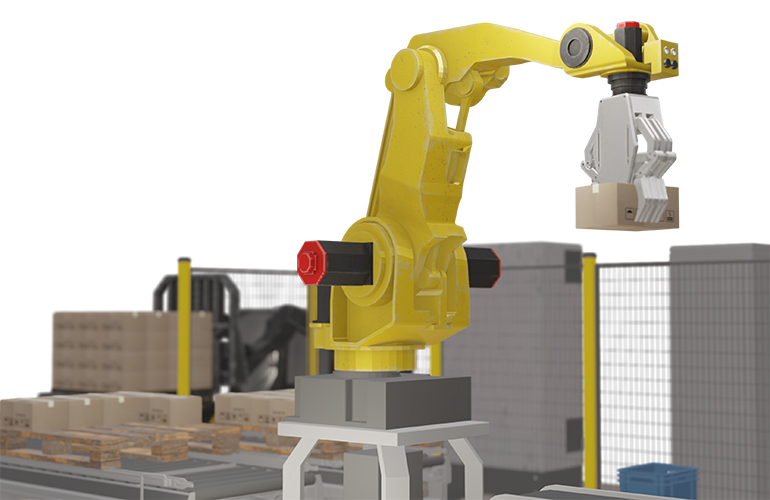|
Listen to this article  |

By Nick Longworth, Business Consultant – Industrial Robotics
Most manufacturers and logistics operations implement depalletization processes for the unloading of palletized goods from a pallet. This process is typically done manually using specialized equipment to unload the pallet safely and quickly.
Labor gap issues have forced these operations to consider automating this process using industrial or collaborative robots, but this task is difficult due to mixed SKU pallets along with misshapen boxes and deformed stacks on arrival caused by shipping processes.
Manual vs Automated
Manual depalletization time varies depending on the number of pallets, the size of the pallets, and the types of goods that are being depalletized. Generally, manual depalletization can take anywhere from 15 minutes to an hour for a single pallet. Because of this, it is a labor-intensive process and carries specific ergonomics-related risks. Additionally, it can be dangerous if the goods are not properly secured or if the pallets are not stacked properly.
On the other hand, automated depalletization can save a significant amount of time by having robots complete work humans would have done previously. It also continues to prevent potential injuries associated with manual depalletizing.
Automated Depalletization Benefits
Automated depalletization can improve speed, accuracy, and safety of the material handling process. Automated depalletization using SICK’s PLB 3D vision robot guidance system and an industrial robot is a great way to automate the process and reap the many benefits that come with it.
The first benefit of automating the depalletization process is increased productivity. Automating the process allows for faster and more efficient removal of items from the pallet, as the robot can move around the pallet much more quickly than a human worker. This eliminates the need for manual labor, reducing the amount of time needed to complete the task. Automation also eliminates the need for additional personnel to monitor the process.
Another advantage of automated depalletization is increased safety. When the process is automated, there is no risk of workers getting injured while handling the pallet or the items it contains. This reduces the potential for workplace accidents and injuries, which can be costly both financially and in terms of lost productivity. Automation also ensures that the task is carried out correctly, as the robot will be able to accurately pick up and move the items without any mistakes.
Automation also improves accuracy. As the robot can accurately pick up and move the items on the pallet, there is less risk of the items being misplaced or damaged. This eliminates the need for manual inspection of the items, as the robot will be able to accurately place the items in the correct location. This decreases the amount of time needed to complete the task and ensures that the items are correctly placed and stored.
Lastly, automating this process increases plant availability. With labor shortages across industry, having a robot complete a task previously required to be done by a human eliminates the need to find labor in a tight market. As a result, the plant can continue to operate at a high level of production without interruption.
How Robot Guidance Systems Help
Robot guidance systems, such as the PLB vision system from SICK, are the ideal solution for automated depalletization by being able to identify objects and tell the robot and end effector to pick up the object, moving into to a precise point on the pallet or off the pallet. The system can be used with most brands of industrial and collaborative robots. The system is designed to easily integrate with these robots, allowing for easy installation and setup. Additionally, it is designed to be easily installed with low coding or no coding configurable interfaces. This makes the system extremely versatile in a variety of different applications and deployed at a rapid rate.
The PLB vision system helps the robot understand the 3D world allowing them to pick and place items from the pallet autonomously, quickly, and accurately. There are options for robot mounted and fixed mounted for large volumes of view, which enables fast and easy localization of many different part box and packaging types.
In addition, automated depalletization using SICK’s PLB system and an industrial robot is also cost-effective. Automating this laborious task not only addresses current labor gap issues all companies are currently facing, but it also helps reduce the risk of workplace accidents and injuries, which can be costly in terms of lost productivity and worker’s compensation costs. The overall cost of the PLB system is also relatively low as compared to other vision-based solutions on the market, with no need for vision or coding experience to operate these systems. In addition, there is perpetual licensing and no recurring costs associated with the PLB system. Other companies often require annual maintenance fees, which can make ROI targets with the system difficult to achieve.
In conclusion, automated depalletization using a 3D vision robot guidance system and an industrial robot is an ideal solution for logistics operators and manufacturers. Automation increases productivity, accuracy, and safety while reducing labor costs and the risk of workplace accidents and injuries.
Sponsored content by SICK
Credit: Source link


Comments are closed.